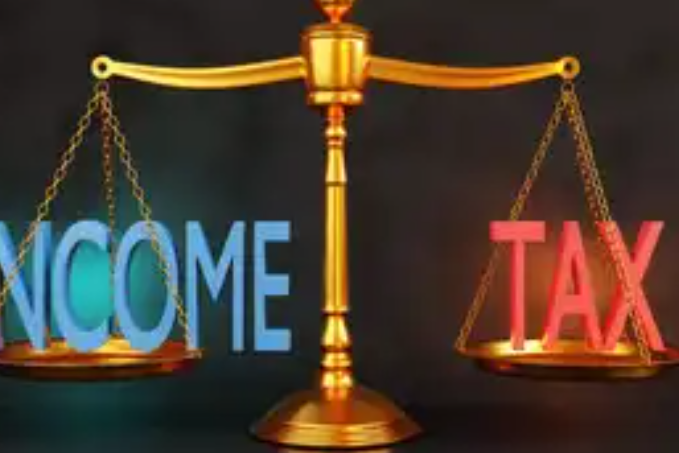“They knew the situation they were in, but decided to leave immediately.” Rajesh works at an IT firm in Bangalore. He makes ₹12 lakhs every year and that is a good salary. But after income tax, GST on all his purchases, property tax on his tiny flat and toll taxes to use roads, he’s little better off than if he didn’t work at all. Come the end of each month, there is little remaining for his children’s education or his parents’ medical needs.
This is the story of millions of middle-class Indians now. With a good income, they’re feeling stretched by the increase in prices and the burden of taxation. Let’s look at how the tax situation in India is squeezing normal working-class families.
The Truth About India’s Tax Collection
India imposes taxes in two primary fashions: direct taxes (such as income tax) and indirect taxes such as GST. The interesting part? In fact only 2-3% of Indians pay income tax. This small section, mainly of the middle class salaried persons, has been put to carrying the load for the entire country of a population of 140 crore.
Consider it this way: you have 100 students in a class but only 2-3 are paying into the class fund for everyone’s benefit to use the facilities. That’s precisely what is occurring with India’s tax code.
Who Really Pays Taxes in India?
Key Fact: As of 2024, India has close to 8.5 crore income tax payers registered with the government, but only around 2.5 crore pay any tax after subtracting exemption and deductions. That is less than 2 percent of our population!
Deconstructing the Tax Minefield for Middle-Class Parents
An Indian from middle-class doesn’t pay just one tax. They pay multiple dues every year, in many cases without even being aware of doing so. Let’s unpack this in plain English.
Income Tax: The Biggest Bite
Here is how income tax works under the new tax regime for Financial Year 2024-25:
| Annual Income | Tax Rate | What You Get |
|---|---|---|
| Up to ₹3 lakh | Nil | You get every bit of salary |
| ₹3 – ₹7 lakh | 5% | For every ₹100 earned, you take home only ₹95 |
| ₹7 – 10 lakh | 10% | For every ₹100 earned, you take home only ₹90 |
| ₹10 – 12 lakh | 15% | For every ₹100 earned, you take home only ₹85 |
| Above 12 lakh | 20% | For every ₹100 earned, whatever will be remaining is yours; with a cap at 30% |
But wait, there’s more! Levy a 4% Health and Education Cess on your tax. So if your tax is ₹1 lakh, you pay ₹1,04,000.
GST: The Silent Tax Collector
GST is an issue at every purchase you do. Every time you stock up on groceries, shop for clothes or electronics or eat at a restaurant, the purchase price has GST baked in.
GST Rates on Common Items
- 0% – Essential Foods
- 5% – Sugar, Tea, Coffee
- 12% – Mobile Phones
- 18% – Electronics, Clothes
- 28% – Cars, AC, Fridge
Reality Check: What this means is that if a middle-class family spending ₹50,000 a month on products and services today gives up to ₹7,000-10,000 of GST every month. That’s ₹84,000-1,20,000 per year!
The Shadow Taxes No One Talks About
Besides income tax and GST, middle-class Indians pay so many other taxes:
Property Tax: If you have purchased a house, you need to pay property tax to the municipal corporation of your area every year.
Road Tax: You pay 8-20% road tax at the time of purchasing a car depends on the state you live in.
Toll Tax: Using highways? Pay toll at every booth.
Fuel Tax: Taxes (excise duty + state VAT) make up nearly 50% of the price of petrol and diesel.
Professional Tax: Up to ₹2,500 per annum for being employed by a job in the states.
Stamp Duty: Buying property? Pay 5-7% of the property value as stamp duty.
TDS: Tax deducted at source (on salary, interest, rent etc.)
Why the ‘Middle Class’ Pays Most
The Salary Trap
For salaried middle-class people, there is a special problem. The government can see their entire income. TDS: Most people do not even get their salary in the bank account as it is deducted before a person withdraws money through TDS (Tax Deducted at Source). They can’t shelter income or otherwise underreport earnings.
Compare that to businesses and professionals who can demonstrate a wide range of expenses, take deductions, and legally minimize their tax obligation. A shopkeeper with an income of ₹15 lakh may end up paying less tax than a software engineer earning ₹12 lakh.
Agricultural Income: The Big Exemption
In India, agricultural income is completely tax-free — there’s no limit to how much you can earn. This is progressive and beneficial to small farmers, but rich landlords with crores in agricultural income also pay zero tax. The lower employee, who earns ₹10 lakh as income tax, may be paying the taxes; but a man earning ₹10 crore through agriculture does not have to pay income tax.
For more insights on tax policy and legal matters, visit Zista Legalis.
The Cash Economy Problem
A sizeable chunk of India’s economy continues to operate on cash even after demonetization, the digital push. A lot of small businesses, traders and service providers deal in cash, so it is difficult to gauge the actual income. The middle class that receives a salary cannot do this — every rupee they earn is accounted for.
Its Cost of Living Multiplies the Pain of Tax
Housing: 7% stamp duty, registration cost and property tax shooting up the property costs.
Education: School fees going up 10-15% every year and at 18% GST on private coaching and educational material.
Healthcare: Hike in the medical expenses – 12% GST on health insurance premium and hospital bills. The government is likely to increase it by 3% from the previously applicable 9%.
Transportation: Very high vehicle cost (28% GST), fuel prices (50% taxes) and toll charges for every road.

A Monthly Budget Reality Check
Then take the case of an average middle class family whose joint annual income is ₹15 lakh and lives in metro city:
| Expense Category | Monthly Amount (₹) | Tax Included |
|---|---|---|
| Income Tax + Cess | 18,750 | Direct Tax |
| Rent | 25,000 | No |
| Groceries & Household | 15,000 | GST |
| Fuel & Transportation | 8,000 | Heavy Taxes |
| Utilities (Electricity, etc.) | 5,000 | GST |
This is almost one third of a middle class family’s income toward taxes of various types—and that doesn’t even include those big one-time expenses for which you work your tail off (e.g., new car, down payment in a house, medical emergency)!
What Other Countries Do Differently
Better Services for Tax Money
In places such as Germany, Sweden or Canada, high taxes mean better public services:
- Healthcare for everyone, free or low cost
- Quality public schools on a par with private schools
- Clean, safe public transportation
- Well-maintained roads and infrastructure
- Generous social security and unemployment benefits
In India, middle-class families still often have to pay separately for private health care, private schools and even in many cases basic infrastructure like water supply and security despite paying taxes.
Wider Tax Base
The population of developed countries based on 40-60% pay income tax. In India, it’s less than 2%. The more that people contribute the less everyone has to contribute. And other nations have far tougher enforcement measures and a culture of voluntary compliance.
Learn more about how tax systems work in different countries at the OECD Tax Database.
Why Tax Overhauls Keep Missing the Mark
Promises vs. Reality
The middle class always gets tax relief in every budget speech. The simplified tax, now regressive in nature was part of the new taxation system. Yet most middle-class taxpayers do better under the old regime with deductions.
In Budget 2024, the standard deduction moved from ₹50,000 to ₹75,000 but such a token gesture amounts to virtually nothing when inflation is eroding purchasing power at an annual rate of 6-7%.
Focus on Indirect Taxes
The reason is the government is increasingly dependent on indirect taxes — like GST — since they are easier to collect and everybody pays them. But indirect taxes are more painful for the poor, and poorer middle classes, because everyone pays the same rate irrespective of income. If you are earning ₹5 lakh and the other person is earning ₹50 lakh, then both of you pay 18% GST on a mobile phone.
-
⚖️ See how India’s legal system drives economic fairness: How India’s Legal System Shapes Economic Fairness
The Saving and Investing Squeeze
Rising Financial Pressure
Middle-class Indians are traditionally savers. They are saving for children’s education, weddings, medical emergencies and retirement. But with heavy taxation and mounting costs, that doesn’t leave much room for savings.
Saving Shortage: India has dropped to a 47-year low in its household savings rate, new figures show. Middle-class families have the lowest savings rate in a few decades and are in no position to survive financially any kind of setback.
Tax on Investments Too
And even when middle-class Indians have savings they can invest, taxes don’t trail far behind:
- Interest on bank is taxed at your slab rate
- Capital gains tax on stocks and mutual funds (12.5% long term, 20% short term for equity)
- Tax on rent income if you purchase a 2nd property
- GST on insurance premiums
The Emotional and Social Cost
Delayed Life Decisions
Middle-class families are too heavily taxed and pay high costs that have them deferring important decisions in their lives. Young couples delay having children (kids are expensive!). Indeed, when you are spending 50% of salary on tax/rent/food/security you can forget about buying a house.
The Migration Question
More and more well-educated middle-class professionals contemplate relocating overseas. Countries such as UAE have zero personal income tax and countries like Canada and Australia have much higher taxes but better quality of life. India suffers from brain drain in part because the tax-to-benefit calculus just doesn’t work for the educated middle class.
What Can Really Change?
Expanding the Tax Base
The vital reform is to include more people in the tax base. And they naturally feel overburdened when only 2% of them pay income tax. Efficient monitoring of cash transactions, promoting digital payments and taking stringent actions against tax evaders can ensure a more equitable sharing.
Improving Public Services
If citizens get some sort of benefit out of it, then taxes won’t seem so bad. Quality public health, government schools that work well, good public transport and safe neighbourhoods will lessen the burden on middle class families who have to pay a premium for private services.
Simplifying Tax Structure
Numerous taxes, ever-changing rules and cumbersome compliance lead to confusion and frustration. A simpler, more transparent tax system with fewer slabs and clearer rules would be a start.
Protection for Salaried Class
Because salaried workers can’t hide income, they require more deductions and exemptions. Some real relief would come from increasing limits for health insurance deductions, money spent on education and benefits on housing loan installments.

Taxes and the Middle Class: Common Questions
Q1: How is it that only 2% of India pays income tax?
According to India’s per capita income of ₹3 lakh a year, only those earning ₹10 lakh a year and above are included among one crore taxpayers. On the other hand, farm income is tax-free, a section of the business prefers cash transactions so that they can avoid digital trail and there is a huge informal sector where tracking income is hard. It is the salaried middle class that ends up paying the most taxes as all of their income can be seen through TDS.
Q2: Are middle-class taxpayers better off under the new tax regime?
It depends on individual circumstances. For people who do not have large investments or house loans to worry about, the new regime could provide somewhat lower rates. But for households which have home loans, insurance and investments — the three sure-shot triggers of deductions — the old regime with deductions still typically translates to a lower tax liability.
Q3: How much GST does a middle-class family pay every year?
On average, a family belonging to the middle class pays ₹80,000-1,50,000 per year on account of GST. This applies to the GST that is paid on groceries, clothes, electronics, eating out and entertainment as well as on services such as insurance and phone bills.
Q4: Why does a rich person not pay more taxes based on a regular incremental system?
Income tax rates are indeed progressive — the more of it you make, the higher your rate – but rich people get lots of their income from all sorts of places (capital gains, dividends, business profits) that are seriously undertaxed. They also have the means to engage in tax planning via legal mechanisms to reduce their tax exposure.
Q5: Can taxes on the middle class be cut?
Yes, but it has to come with structural reforms: growing the tax base so more people contribute; cutting indirect taxes which hit everybody at once; improving public services, so that families don’t spend in the private sector what they already spent in the public one; and creating more tax reliefs for typical middle-class salaried workers.
Q6: What is done with all the money that’s been collected in taxes?
Money collected from tax is used by the government to carry out its operations, maintain infrastructure and defense; distribute subsidies, provide welfare schemes, undertake social-security measures, implement public safety etc. that are in the overall interest of the society. But the question is, do middle-class taxpayers get equivalent value to what they’re putting in from these expenses?
Final Thoughts: The Path Forward
India’s middle class is the engine of the economy — it powers consumption, drives innovation and ensures social stability. And yet, they are getting squeezed between heavy taxation and rising prices for goods — with not much in the way of public services to show for it.
The tax burden is not just a set of numbers on your pay slip. It shapes actual choices — should I have another child, should I buy a house or support aging parents, can I afford an education? When a family does the math and realizes that one-third or more of its income vanishes into various taxes, the strain is palpable.
Change can happen, but only through honest conversation regarding who is paying taxes and who should be paying more — and how the money should be spent. A tax system that is fair should not make honest, hardworking Indians feel punished simply for following the rules.
Until reform comes and the tax base is broadened, services for all are improved, and working people get meaningful relief, the middle class will keep feeling crushed by a load that only appears to grow heavier every year. It’s not whether they can afford to pay — it’s whether they can afford not to be heard.
For more articles on legal and tax matters, visit Zista Legalis





